Arado Ar E.381 I Component Diagram
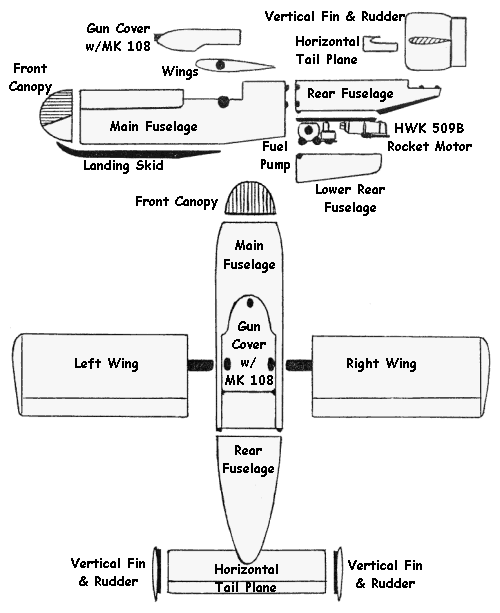
Arado Ar 234C-3/Ar E.381 I - October 31, 1944
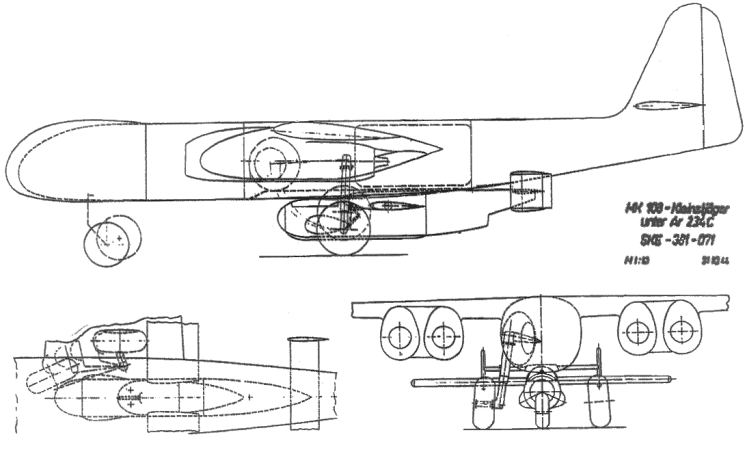
Arado Ar 234C-3/Ar E.381 II - December 1, 1944
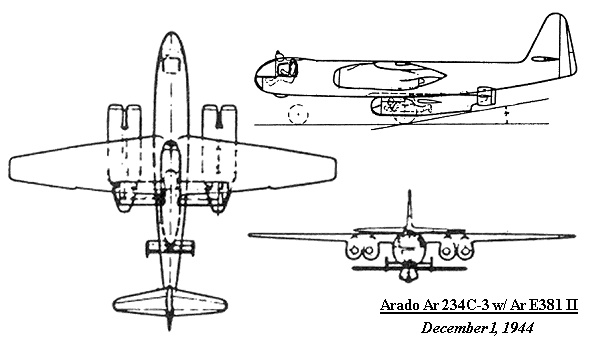
Cutaway drawings of the Arado Ar E.381 II


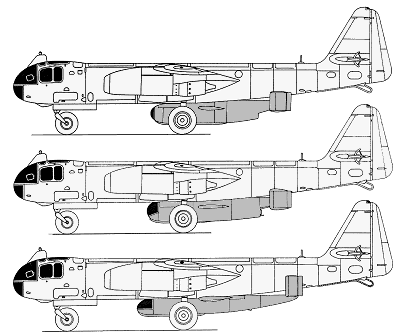
|
Ar E.381 I Ar E.381 II Ar E.381 III |
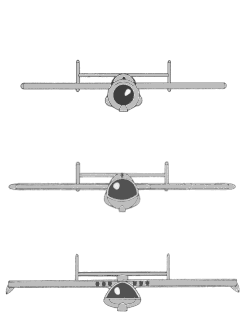
|
Arado Ar E.381 III with landing skid retracted and braking parachute deployed

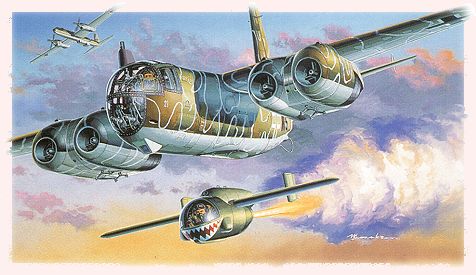

Color images: Top - DML/Dragon model boxtop
Bottom - Luftwaffe Secret Projects Vol. 3
Thanks to Justo Miranda for many of the above drawings
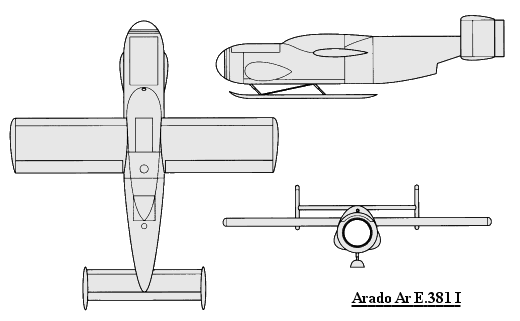 The first version had
a circular cross-section fuselage, with a small round window in the
nose for the pilot's vision. Overall, the entire fuselage was protected
by a 5mm armored shell. The pilot lay in a prone position, and the cockpit
was very cramped. A removable 140mm (5.5 inch) armored glass screen
was mounted in front of the pilot. Two small bulges were located on the
fuselage sides for the pilot's elbows. Alongside the pilot's legs were
two C-Stoff (one component of the rocket fuel) fuel tanks and by his feet
a single T-Stoff fuel tank. The wings were straight and mounted midfuselage,
with a stepped bulge above the wings which held the single MK 108 30mm
cannon with 60 rounds. The rocket engine exhausted beneath the tail
unit which featured a twin fin and rudder setup. A retractable
skid could be lowered for landing and a drag parachute (ejected from
a hatch on the top rear fuselage) was also to be used upon landing. The
aircraft could only be entered from a hatch above the cockpit, so the
pilot had to enter the E.381 before the aircraft could be attached to the
carrier Ar 234C-2 and had no way to escape in case of emergency.
The first version had
a circular cross-section fuselage, with a small round window in the
nose for the pilot's vision. Overall, the entire fuselage was protected
by a 5mm armored shell. The pilot lay in a prone position, and the cockpit
was very cramped. A removable 140mm (5.5 inch) armored glass screen
was mounted in front of the pilot. Two small bulges were located on the
fuselage sides for the pilot's elbows. Alongside the pilot's legs were
two C-Stoff (one component of the rocket fuel) fuel tanks and by his feet
a single T-Stoff fuel tank. The wings were straight and mounted midfuselage,
with a stepped bulge above the wings which held the single MK 108 30mm
cannon with 60 rounds. The rocket engine exhausted beneath the tail
unit which featured a twin fin and rudder setup. A retractable
skid could be lowered for landing and a drag parachute (ejected from
a hatch on the top rear fuselage) was also to be used upon landing. The
aircraft could only be entered from a hatch above the cockpit, so the
pilot had to enter the E.381 before the aircraft could be attached to the
carrier Ar 234C-2 and had no way to escape in case of emergency. 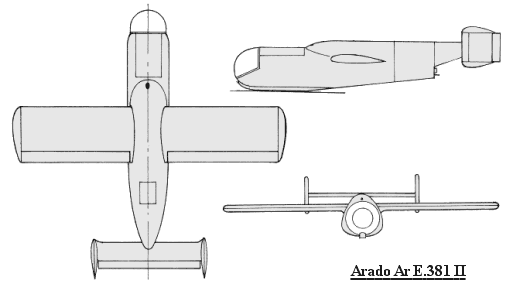 The second version was very
similar to the first version of the Ar E.381. The overall dimensions
were enlarged slightly, but the basic layout remained the same. The
front canopy was enlarged, giving the prone lying pilot better vision
out of the still cramped cockpit. A slight step still remained aft of the
entry hatch atop of the forward fuselage, and a single MK 108 30mm cannon
(45 rounds) was still mounted here, firing over the cockpit. The tail unit
was similar, with the fins being slightly smaller and rounder. Landing
was accomplished by means of a built-in landing skid and the same drag
parachute, and the same means of entering and exiting the second version
of the E.381 (via a hatch on top of the fuselage) remained from the first
version.
The second version was very
similar to the first version of the Ar E.381. The overall dimensions
were enlarged slightly, but the basic layout remained the same. The
front canopy was enlarged, giving the prone lying pilot better vision
out of the still cramped cockpit. A slight step still remained aft of the
entry hatch atop of the forward fuselage, and a single MK 108 30mm cannon
(45 rounds) was still mounted here, firing over the cockpit. The tail unit
was similar, with the fins being slightly smaller and rounder. Landing
was accomplished by means of a built-in landing skid and the same drag
parachute, and the same means of entering and exiting the second version
of the E.381 (via a hatch on top of the fuselage) remained from the first
version.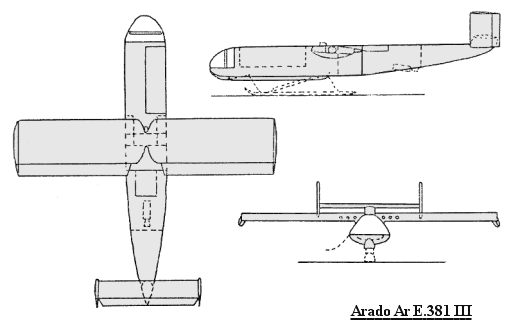 With the third E.381 design,
the overall dimensions were again enlarged slightly. The fuselage
shape was designed as a triangular cross-section now, which presented
an even smaller front cross-section. The step above the fuselage was
eliminated, and the wing was now a shoulder mount design. Also,
the wing tips were turned downwards, to act as skids once the plane landed
and tipped from side to side. Instead of a single MK 108 30mm cannon,
the third version was armed with six RZ65 or 73 spin-stabilized rockets
fired from the wing leading edges. The tail unit was redesigned to sit
slightly higher than the fuselage and the fin and rudders changed to a
simpler rectangular shape. Landing was the same as the first two versions,
via a retractable landing skid and drag parachute. The problem of
entering or exiting the E.381 was solved by adding a side-opening hatch
on the starboard side of the forward fuselage.
With the third E.381 design,
the overall dimensions were again enlarged slightly. The fuselage
shape was designed as a triangular cross-section now, which presented
an even smaller front cross-section. The step above the fuselage was
eliminated, and the wing was now a shoulder mount design. Also,
the wing tips were turned downwards, to act as skids once the plane landed
and tipped from side to side. Instead of a single MK 108 30mm cannon,
the third version was armed with six RZ65 or 73 spin-stabilized rockets
fired from the wing leading edges. The tail unit was redesigned to sit
slightly higher than the fuselage and the fin and rudders changed to a
simpler rectangular shape. Landing was the same as the first two versions,
via a retractable landing skid and drag parachute. The problem of
entering or exiting the E.381 was solved by adding a side-opening hatch
on the starboard side of the forward fuselage.